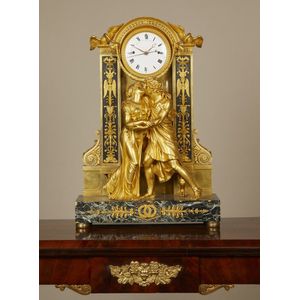French Empire Ormolu Mantel Clock with Bentley & Beck Movement
You must be a subscriber, and be logged in to view price and dealer details.
Subscribe Now to view actual auction price for this item
When you subscribe, you have the option of setting the currency in which to display prices to $Au, $US, $NZ or Stg.
- Movement - The technical name for the workings of a clock or watch, and does not include the dial or case.
- Foliate - Decorated with leaves or leaf-like forms.
- Fusee - The fusee movement was used in clocks and pocket watches from the mid 17th century. The fusee is a cone shaped drum within the works that is linked to the barrel of the spring, usually by a length of chain.
As the mainspring loses its tension over time, the cone shaped barrel compensates for this by increasing the tension, by pulling the mainspring tighter, thus ensuring the time remains constant.
Use of the fusee in clocks was superseded by the "going barrel" in the mid 19th century and for pocket watches at the beginning of the 19th century.
The fusee continued to be used in marine chronometers until the 1970s. - Bronze - An alloy of copper and tin, traditionally in the proportions of about 9 parts of copper to 1 part of tin.
The discovery of bronze in Western Asia in the 4th century enabled people to create metal objects which were superior to those previoulsy possible because of its strength and hardness, and it has been used throughout the world for weapons, coins, tools, statuary and other decorative items.
It is very fluid in a molten state, and its hardness, strength when set, and non-corrosive properties makes it most suitable for casting sculpture. - Floral Swag / Garland / Festoon - Floral swags are a decorative motif often used in the ornamentation of various objects, such as silverware, glassware, and furniture. The term "swag" refers to a garland or wreath of flowers, foliage, or other decorative elements, which is usually arranged in a loop or curve.
Floral swags can be found in a variety of decorative styles, from ornate Baroque and Rococo designs to more naturalistic Art Nouveau and Art Deco styles. They are often used to add a touch of elegance, refinement, or whimsy to an object, and can be seen on a range of items from chandeliers and candlesticks to picture frames and tea sets.
In the decoration of silver objects, floral swags are often used to accentuate the curves and lines of the piece, and to add visual interest to the surface. Similarly, on glass objects, floral swags may be used to frame or highlight a particular area of the object, or to add a touch of color and delicacy.
On furniture, floral swags can be found on a variety of pieces, from cabinets and armoires to chairs and sofas. They are often used to enhance the lines and curves of the furniture, and can be used to create a sense of movement and flow in the design.
Overall, floral swags are a versatile decorative element that can be adapted to a range of styles and applications, and have been used in the decoration of various objects throughout history. - Ormolu - Ormolu was popular with French craftsmen in the 18th and 19th century for ornamental fittings for furniture, clocks and other decorative items. True ormolu is gilt bronze, that is bronze that has been coated with gold using a mercury amalgam. Due to the health risks associated with using mercury, this method of creating ormolu was discontinued in France in the 1830s. A substitute was developed consisting of about 75% copper and 25% zinc, however it was inferior to the bronze version. It was often lacquered to prevent it tarnishing.
This item has been included into following indexes:
Visually similar items

A fine late 19th century French gilt metal clock, with 8-day movement, the face with light blue champleve enamel work and Roman numerals, flanked with finely cast caryatids and conforming champleve sides on bun feet, 36 cm high

James & Walter Marshall late Napoleonic gilt bronze & porcelain clock made in Paris, hand painted with cherubs below the face & flanked by two columns hand painted with birds accentuated with gilt accents, two acorn finials centred by an applied lidded urn

American Ingraham wood cased mantle clock, carved wood case and pediment. Key and pendulum available. Appears operational, however, untested. Height 64 cm

George III longcase clock the swan neck pediment with bird and orb finial, arched painted enamel dial with Roman and arabic numerals, subsidiary second and calendar dials in an inlaid mahogany case
